CELLULAR AGRICULTURE: BENEFITS AND PROSPECTS
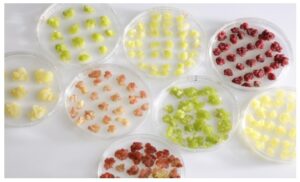
In Blade Runner 2049 (2017), a dystopian sequel to the original Blade Runner movie, a character eats a synthetic, lab-grown steak. This brief scene touches on the possibility of using cellular agriculture to create more sustainable and humane meat alternatives. Similarly, Okja (2017), a science fiction movie focuses on a young girl’s quest to save her genetically-engineered “super pig” from being slaughtered. The movie touches on the themes of factory farming and the potential benefits of cellular agriculture. In “The End of Animal Farming” Jacy Reese, makes a case for ending animal agriculture altogether and transitioning to plant-based and lab-grown alternatives. It discusses the potential benefits of cellular agriculture in depth. And in “Clean Meat: How Growing Meat Without Animals Will Revolutionize Dinner and the World” Paul Shapiro, explores the history and future of cellular agriculture, and argues that lab-grown meat has the potential to solve many of the world’s most pressing problems. Josh Berson in “The Meat Question: Animals, Humans, and the Deep History of Food”, takes a deep dive into the history of meat production and consumption, and explores the potential of cellular agriculture to transform the industry.
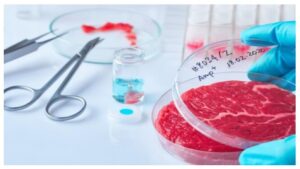
Cellular farming, also known as cellular agriculture, is a new approach to food production that involves using cellular and molecular biology techniques to create animal products without the need for traditional animal husbandry. It involves taking cells from animals, such as cows, pigs, or chickens, and culturing them in a lab setting to grow meat, eggs, and dairy products. This lab-grown food is also
sometimes referred to as cultured meat or clean meat.
There are several reasons why cellular farming is becoming an increasingly popular area of research and development. One of the main reasons is sustainability. Traditional animal agriculture is a major contributor to greenhouse gas emissions and is responsible for a significant portion of deforestation and
water usage. Cellular farming offers a more sustainable and environmentally friendly way to produce animal products without the need for large-scale farming.

Another reason for the development of cellular farming is animal welfare. Traditional animal farming involves raising animals in often cramped and stressful conditions, which can result in suffering and negative health outcomes for the animals. By producing meat, eggs, and dairy products in a lab, cellular farming eliminates the need to raise and slaughter animals for food.
Cellular farming also has the potential to create new and innovative food products that are not possible with traditional animal agriculture. For example, lab-grown meat can be made with precise fat and protein content, which could help to create healthier and more nutritious food products. Additionally, cellular farming could enable the creation of new meat products that are not traditionally consumed,
such as exotic meats, without harming any animals.
Overall, cellular farming has the potential to transform the way we produce and consume animal products, offering a more sustainable, humane, and innovative approach to food production.
The main advantage of cellular farming is that it eliminates the need for animal slaughter. Stem cells are extracted from animals and then cultured in a lab. These cells can then be used to produce a variety of products, from milk and eggs to meat. By eliminating the need for animal slaughter, the process of cellular farming is expected to reduce the environmental impact of the food industry.
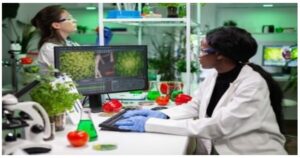
Cellular farming is also a more efficient way of producing food. By growing cells in a lab, the process of cellular farming allows for greater control over the environment, allowing for the production of high-quality proteins. In addition, the process is much faster than traditional farming methods, as cells can be grown in a matter of days.
Cellular farming is also more economical since it requires fewer resources. The process of growing cells uses fewer resources than traditional farming methods. This is because the lab environment is much more efficient at producing proteins. Additionally, the process of cellular farming eliminates the need to transport food from farms, resulting in fewer emissions.
Overall, cellular farming is an innovative and exciting technology that has the potential to revolutionize the food industry. It eliminates the need for animal slaughter, allows for greater control over the environment, and is much more efficient and economical. With the emergence of lab-grown meat and dairy products, the possibilities for cellular farming are endless.
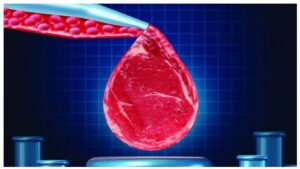
Ongoing research on cellular farming is being conducted all over the world. In the United States, companies like Memphis Meats, JUST, and Aleph Farms are actively working on developing lab-grown meat products. Memphis Meats, for example, has developed lab-grown chicken and beef, while Aleph Farms has developed lab-grown steak. These products are currently not available for mass consumption,
but the companies are working towards making them commercially viable. In Europe, companies like Mosa Meat and SuperMeat are also working on developing lab-grown meat products. Mosa Meat has developed a lab-grown hamburger, while SuperMeat is working on developing lab-grown chicken meat.
These products are still in the development stage and are not yet available for mass consumption.

In Asia, companies like Shiok Meats in Singapore and Integriculture in Japan are also working on developing lab-grown meat products. Shiok Meats has developed lab-grown shrimp, while Integriculture is working on developing lab-grown foie gras. These products are also in the development stage and are not yet available for mass consumption.
The cost of lab-grown meat products is currently high due to the expensive technology involved in producing them. However, as technology becomes more advanced and production processes become more efficient, the cost of these products will likely decrease in the future.

Cellular farming is also gaining traction in India. In 2020, the Indian Institute of Technology (IIT) in Delhi announced that it had successfully developed lab-grown meat using stem cells from chicken embryos. This breakthrough could potentially lead to the development of lab-grown meat products in India in the future.
The prospects of cellular farming are promising. It has the potential to revolutionize the food industry and provide a sustainable way to produce food. Additionally, it could also be used to produce medicines and other products in a lab setting. However, there are still challenges to be overcome, such as the high cost of production and regulatory issues.
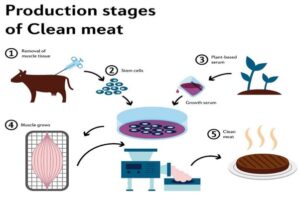
The mechanism of cellular farming involves taking stem cells from animals and culturing them in a lab setting. The cells are supplied with the necessary nutrients to help them grow and proliferate. The cultured cells are then used to develop meat or other products in a controlled environment, without the need for large-scale farming. This process is more efficient and sustainable than traditional farming and has the potential to reduce the burden on the environment. Cellular farming is an innovative, cutting-edge technology that has the potential to revolutionize the food industry. It involves the use of stem cells taken from animals or plants to grow edible products such as cultured meat and dairy products. This
process is also known as “in vitro cultivation” and involves growing cells in a lab-controlled environment.
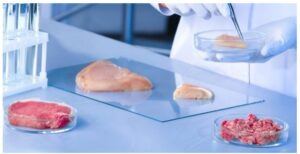
CONCLUSION
Cellular Farming – a new approach to food production – is gaining a lot of attention in recent times. It is a process where stem cells are taken from animals and cultured in labs to grow protein-rich foods like lab-grown meat. Cellular farming is a revolutionary concept as it offers a sustainable way to produce food and has the potential to reduce the burden on the environment.
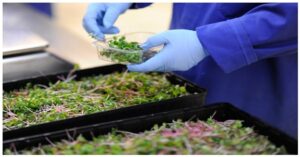
Cellular farming involves taking stem cells from animals like cows, pigs, and chickens, and culturing them in labs. During the process, the cells are supplied with the necessary nutrients to help them grow and proliferate. The cultured cells are then used to develop lab-grown meat products such as burgers and sausages. This meat is identical to the meat produced from animals, but it is produced in a lab with much less energy and resources. Cellular farming also has many advantages over traditional farming. It is more efficient and has the potential to reduce the cost of food production. Additionally, it does not require large areas for cultivation and does not produce any emissions. Furthermore, it eliminates the
need for large-scale farming, which is detrimental to the environment. Cellular farming also holds great potential for the medical field. Stem cells from animals can be used to create medicines, such as vaccines and drugs, in a laboratory setting. This could help reduce the cost of medical treatments and make them more accessible.
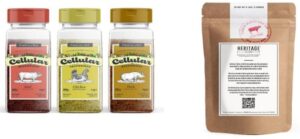
In conclusion, cellular farming is an exciting new approach to food production that holds great potential for the future. It has the potential to reduce the burden on the environment and make food production more efficient. Furthermore, it could also be used to produce medicines in a lab setting, making them more accessible to people around the world.
 Dr K. Jayanth Murali is a retired IPS officer and a Life Coach. He is the author of four books, including the best-selling 42 Mondays. He is passionate about painting, farming, and long-distance running . He has run several marathons and has two entries in the Asian book of Records in full and half marathon categories. He lives with his family in Chennai, India. When he is not running, he is either writing or chilling with a book.
Dr K. Jayanth Murali is a retired IPS officer and a Life Coach. He is the author of four books, including the best-selling 42 Mondays. He is passionate about painting, farming, and long-distance running . He has run several marathons and has two entries in the Asian book of Records in full and half marathon categories. He lives with his family in Chennai, India. When he is not running, he is either writing or chilling with a book.


Feb 27, 2023 at 8:30 PM /
I am curious to find out what blog system you are using? I’m experiencing some minor security issues with my latest blog and I would like to find something more risk-free. Do you have any recommendations?